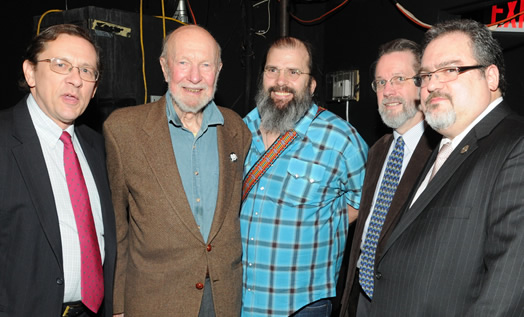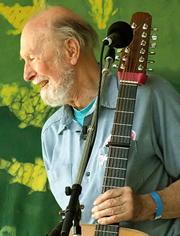Allegro
The Legacy of Pete Seeger
Recording Vice President's Report
Volume 114, No. 3March, 2014

Pete Seeger with the Local 802 officers and singer/songwriter Steve Earle at Local 802’s 90th birthday party and gala in 2011. Photo: Walter Karling.
It’s hard to think of Pete Seeger as gone. A man who took up the landscape in a very large way for seven decades cannot easily slip away from the way we become accustomed to great living people. Pete was a loyal member of this union since 1942, when he began to make his indelible mark on the musical and political character of this land.
Being the dyed-in-the-wool folky that I am, I was barraged with questions about how I felt about Pete’s passing in the days following his death. In fact, it was not an easy question to answer. Though he was 94, the image of those long gangly arms wielding a maul to split firewood at his Beacon homestead made you think he was going to live well beyond the age of 100. In most cases, people who live into their 90s do not surprise us when they die. Not true of Pete Seeger. His songs are so deeply carved into our consciousness, it’s as if they had always been with us. How can there not have been songs like “Where Have All the Flowers Gone,” “If I Had a Hammer” or “Turn, Turn, Turn”?
What was amazing about Pete Seeger is that these were not just compositions to him; they were made up of what was essential to his great character and integrity, which people came to know as much as his music. Pete’s great commitment and conscience accomplished feats that rang in the American zeitgeist many times over. Any one of them would have given him a place in history. Here are, in my mind, the six monumental achievements of Pete Seeger’s life.
UNION SINGER
A radio interviewer asked me the day after Seeger died, “How did Pete become such a supporter of unions?” The question may as well have been, “How did the zebra first get his stripes?” Pete’s musical endeavors began at the height of the CIO movement that created the modern day labor movement. The album that he and Woody Guthrie made as the Almanac Singers, “Talkin’ Union,” was a touchstone of the days of mass industrial organizing and is still used today by singers mining for material to sing for unions. Pete’s partnership with Woody Guthrie and the travels they made to the West Coast, supporting unions with music along the way, are legendary.
INFLUENCER OF POPULAR MUSIC
Out of his musical partnerships on the political left came the unlikely popularity of the Weavers, the singing group Pete was a fundamental part of. Following a steady gig at the Village Vanguard, the Weavers brought “Goodnight Irene,” Leadbelly’s song, to number one on the charts for an impressive 13 weeks. The Weavers’ success (along with Harry Belafonte’s very popular calypso albums) led to the folk music revival of the 1960s. Pete was seen as an undeniable leader of the popularity that followed. Peter, Paul and Mary’s first album, for example, which sold more than a million copies, contained two of Pete Seeger’s songs, “Where Have All the Flowers Gone” and “If I had a Hammer.”
FREE SPEECH DEFENDER
Pete Seeger, in a manner few could muster the courage to do, defied the House Un-American Activities Committee (HUAC) by refusing to testify during the shameful days of the McCarthy era. Seeger refused to answer any questions about his association with others, invoking his rights under the First Amendment. This led to a conviction for contempt of Congress, which was later overturned. Pete found it increasingly difficult to find work, having been blacklisted, as so many were during this period. But Pete took it with grace that was exemplary. Many artists who found themselves on the blacklist despaired. But Pete, though admittedly angry, took it in stride and continued to make his music when and wherever he could. His spirit never flagged and throughout the 1950s continued to perform concerts with the Weavers and to sing for schools, children’s camps and audiences of all kinds.
FREEDOM SINGER
“We Shall Overcome” became the anthem of the American civil rights movement due to Pete’s influence. Guy Carawan brought the song to civil rights leaders at the Highlander Center, where people like Martin Luther King, Jr. and Rosa Parks discussed the strategy of non-violent resistance. But Pete, more than anyone else, used his fame and influence, as well as his unforgettable delivery of the song, to give it the mainstay power we think of today. I have never been to a demonstration or rally of any kind where people are not moved tremendously when the song is sung. Seeger, along with numerous other folksingers, sang at countless events, marches and rallies throughout the civil rights era. Music was emblematic of the struggle and Pete claimed his natural place in the ranks of musicians who were there.

Pete Seeger at the Clearwater Festival in 2007, at the lively age of 88. Photo: Anthony Pepitone via Wikipedia
ENVIRONMENTALIST
Countering the conventional wisdom that the Hudson River could not be cleaned up, Pete almost single-handedly began a regional environmental movement by launching the sailing vessel Clearwater. Remarkably, while the left was correctly preoccupied with civil rights and the Vietnam war, Pete had the foresight and energy to take on the degradation of the environment, becoming a hands-on leader. The Clearwater, sailing up and down the Hudson, was an ingenious way to organize and publicize the increasing threat to the environment. And of course, whatever the event, it always involved music. Pete’s efforts helped lead to the creation of the Environmental Protection Agency, compelling General Electric to dredge the PCBs it had deposited in the Hudson River.
SPIRITUAL LEADER
I know of no other celebrity (despite Pete’s disgust at the idea, he was a celebrity) who was as accessible as Pete was. He answered all his mail personally, a task that would take a full-time staff person for most people. I have never known anyone in New York City activist circles who does not have a personal recollection of Pete Seeger, either from a concert, a children’s summer camp or just a neighbor’s living room. People admired Pete Seeger because he embodied an ideal that very few could reach. (When he rejected Soviet-style Communism for its treachery, he said he would always be a communist with a small “c”.) He would never say no to a request to help out with a good cause. His optimism about the future might seem naïve to many, but Pete’s tenacity would demonstrate to them otherwise. Who else would have taken on the pollution of one of America’s major rivers? And win? He believed unflaggingly in the power of people through grassroots organizing. He supported unions, community activism and small organizations that took on powerful giants. Through Pete’s example, we learned that we could win against all odds. It was his leadership and influence through example that set him apart.
There’s no one to fill Pete’s shoes. He comes from an era when a singer with a guitar or a banjo could stand in front of an audience and keep them enrapt for hours. After his voice gave out, he could still put on a concert by having the audience sing the lyrics, harmonies and all. I knew Pete mostly through union activity, though he passed on some of my songs to other singers. When Local 1000, the AFM local that I helped organize for touring folk musicians, got its charter, Pete was first in line, wanting us to call the union the “un-local.” He was fond of saying, “If we humans are around in a hundred years, it will be because of music.” That may sound optimistic – if you ignore the “if.” Pete knew the world he lived in. If it were left up to him, the “if” wouldn’t be a qualifier. Now it’s up to us to carry on. Thankfully, Pete showed us how.
